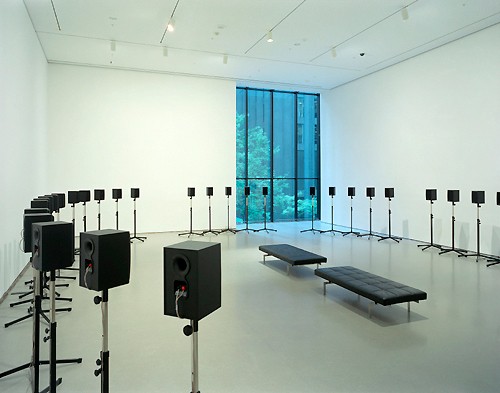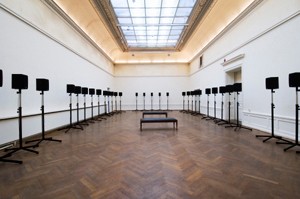
Janet Cardiff, The Forty-Part Motet, 2001 40-kanals ljudinstallation, 14:07 min. Installationsbild från MOMA, New York. Courtesy MOMA, New York
The 1st at Moderna: Janet Cardiff
Forty-Part Motet, 2001
1.2 2006 – 26.2 2006
Stockholm
She recorded each of the 40 voices of the cathedral choir individually. The forty voices are then played back through forty speakers in five groups of eight, in accordance with Tallis’s instructions for the positioning of the choral singers. Sometimes the voices sing at the same time, but the work is created in such a way that certain voices are sometimes quiet and in this way the music moves through the room. The visitor is drawn into the room by the beautiful choral music and walks in between voices which, in an almost spectral way, possess their own identity.

Cardiff has summed up the basic idea of the piece thus, “When you are listening to a concert the only viewpoint normally is from the front, in traditional audience position. With this piece I want the audience to be able to experience a piece of music from the viewpoint of the singers.”
As the experience of the music is dependent on the position of the listeners and the way in which they move through the room, the sound is experienced spatially, three dimensionally, and the work can thus be described as a sound installation.
Forty-Part Motet is not the only work by Cardiff in which she manipulates the viewers’ experience of the room by using sound. In one of her many collaborations with artist George Bures Miller, The Paradise Institute (2001), the audience enters a cinema-like setting. One takes a seat and soon a black and white film starts. The scenes change quickly and apparently irrationally. Soon one begins to hear voices that appear to come from the audience.
A mobile telephone rings. To everyone’s annoyance someone answers and embarks on a loud conversation. However, this and other interfering sounds are part of the work, played back from speakers in the room, which most people realise after a moment of initial uncertainty. But one is left with a feeling of bewilderment as to what is fiction and what is reality. The use of advanced technology seems to blur the boundaries between virtual and real spaces. Experiencing Cardiff’s work, one starts to think about the exact nature of the effect of technology on us. And since the experience is so immediate, the effect becomes more poignant than if it had been presented as an abstract argument. In Forty-Part Motet, the singers are replaced by speakers but their voices are very individual and real.
Cardiff’s Walks, some of which she has made in collaboration with George Bures Miller, work in a similar way. She created her first walk, Forest Walk, in 1991 and has since made some twenty site-specific Walks. The visitor is provided with a pair of headphones, and a whispering voice (Cardiff’s) gives instructions. The intimate, seductive voice and the immediate and gripping story entice the visitor to follow her instructions and walk in the direction she points.
The track of the audio guide also contains environmental sounds that seem to come from different directions. Sometimes one gets a fright and turns around, convinced that someone is approaching from behind – but no one is there. Cardiff’s voice quickly pulls the listener into a story that could be a fascinating science fiction adventure, a murder mystery or a love story. The art of Cardiff (and George Bures Miller) moves with ease between genres and techniques and involves in an effortless way everything from sculpture, film, sound, and choreography to performance and literature.
Janet Cardiff has the unusual ability of making one feel that one is being addressed personally. Paradoxically, at the same time one’s individuality dissolves as the artist’s voice seems to originate from inside one’s own head, almost becoming identical with one’s own thoughts. The guiding voice in the headphones creates in the listener an eerie sensation of surrendering control, and even one’s free will, to an unknown voice. In this way, the experience is similar to an infatuation, and, as I mentioned earlier, seduction plays an important role in Cardiff’s work. After experiencing it, however, a series of questions arise, about one’s self and its dissolution, about the ability of technology to open up virtual worlds and about the blending of fiction and reality.
Curator: Magnus af Petersens
Guided by Voices – The Seductive Art of Janet Cardiff
A choral work composed in 1575 by Thomas Tallis, adapted by Janet Cardiff
Location: Konstnärshuset, Smålandsgatan 7
The exhibition is organised jointly with Stockholm New Music which will be inaugurated on 18 February.
19 February, 1 pm: Conversation between Magnus af Petersens, curator of the exhibition and Janet Cardiff.
The 1st at Moderna is an exhibition programme for contemporary art. The opening is always on the first day of the month, and the exhibitions are in different venues in or outside the museum.
